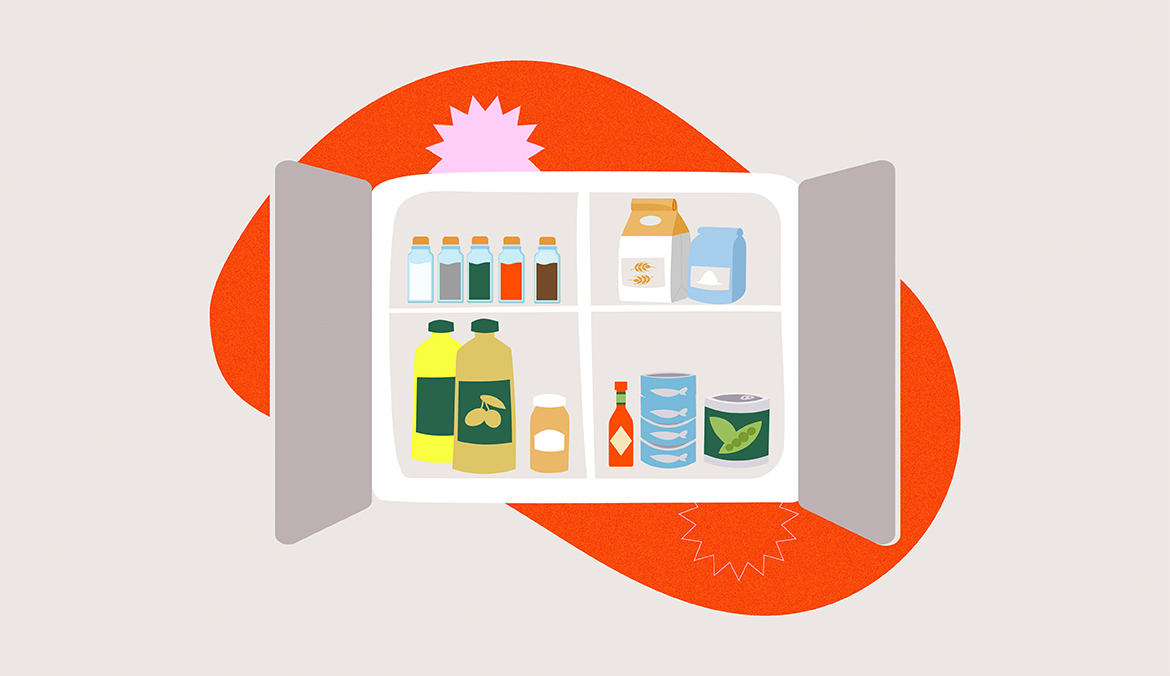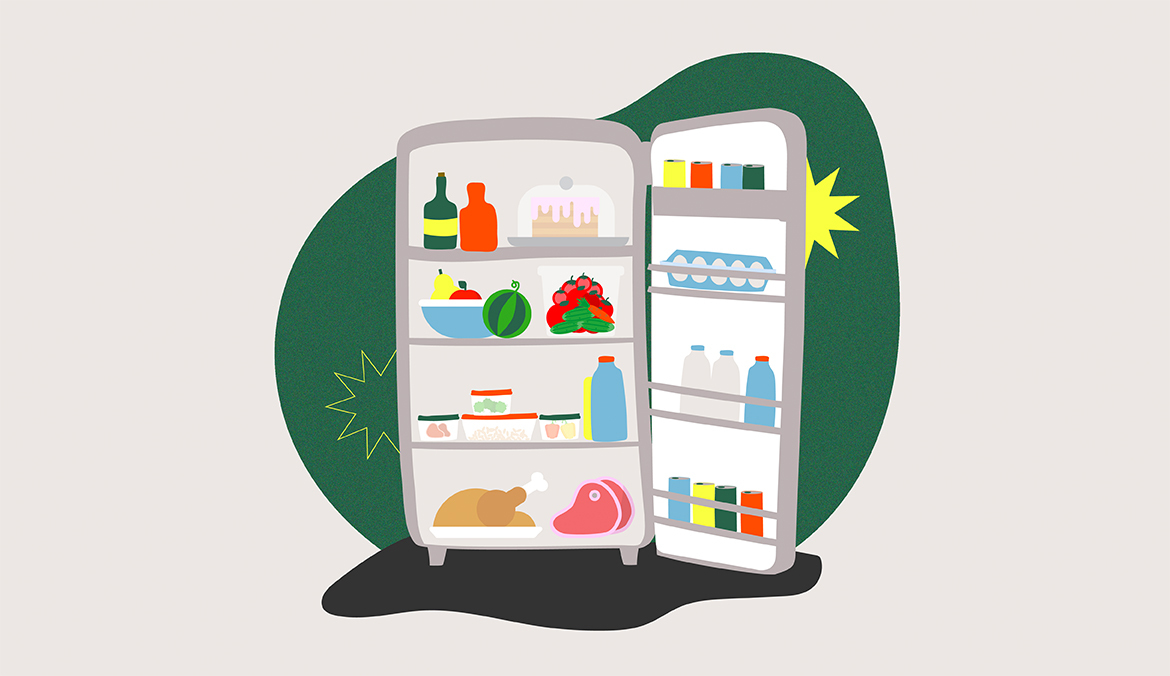Your Foolproof Game Plan for Organizing Your Pantry and Fridge To Reduce Food Waste
Here's a sobering statistic to kick off your 2022: The average American family of four throws out $1,500 worth of food per year, according to the National Resources Defense Council. (That's the equivalent of 1,000 pounds of greens, grains, meat, and beans.) In truth, it would be very difficult to eliminate food waste completely, but experts say that re-organizing the contents of your refrigerator and pantry may be the turnkey that helps you cut down on food waste (for good!).
Below, chef Palak Patel (Well+Good's Renew Year nutrition expert) and other foodies offer their best tips for using every last ingredient in your kitchen. Whether you tend to find mold on your leftovers before you actually get around to eating them, or only ever manage to eat two carrots before tossing the rest of the bag, we've got some solid advice that will carry you through the next 12 months (or... the rest of your eating life). Ready?
- Emily Henderson, interior designer based in Los Angeles
- Palak Patel, award-winning chef and TV personality
How to organize your pantry for peak freshness

Tip 1: Establish your pantry hierarchy
We've all been there: You buy a fresh bag of nutritional yeast only to realize (ugh!) you already have two opened bags in your pantry at home. If you tend to forget what you already have on hand, a pantry hierarchy will be a total lifesaver. Trust us.
"If you don't have a system, then everything turns to chaos. By setting it up, then at least maintenance of it is easier," interior designer, Emily Henderson, previously told Well+Good. "It's just really assessing your own daily habits and what you use when and giving each shelf their own purpose, and then sticking to that. That's the trick because if you don't stick to it, then it's chaos." This means that there's no one "right" way to organize your pantry. Instead, you'll have to decide what items you use most and give them prime real estate in your cabinets.

{{post.sponsorText}}
Here's one way your pantry could look: "On the bottom, so the most easy to reach, is the cereals, snacks, the stuff that you will probably want to grab and go and have easy access to it," says Henderson. "And then the next shelf up was daily cooking: the sauces, the rice, the pasta, the stuff that, again, you want to have pretty easy access to.” Finally baking ingredients, spices, and even canned goods, fo on top because they’re used less frequently, she adds.
But, for the sake of argument, let's say you're really into baking. In that case, you may opt to place ingredients like almond flour, baking powder, cocoa, and chocolate chips on that bottom, most-accessible shelf. Having your cupcake, cookie, and brownie ingredients front-and-center will also ensure you don't accidentally buy, say, another package of coconut flakes unnecessarily.
Basically: It's choose your own pantry adventure.
Tip 2: Try storing ingredients in flavor pairings
When you're whipping up pasta, you probably have three or five Italian-inspired ingredients that you use again and again. So if they're all shelf stable, Patel recommends storing them together for ease of use. "As for those items you tend to forget about, store them alongside items that you typically combine them with in recipes," she says. "For example, there are four or five spices I use almost every time I make Italian-inspired dishes, so I keep all those spices together. If I realize there is another spice that would work well with them that I forget about, I’ll add it to the group. That way, the next time I’m making lasagna or ravioli, I’ll remember to use it. This is an easy—and inspiring!—way to experiment with flavor, too."
Tip 3: Move your spices and oils—which are sensitive to light and heat—to the pantry
Many folks tend to store their cooking oils and spices next to the stove, but experts say that doing so may actually shorten their lifespan. Olive oil ages faster in the presence of light, air, and heat—so make sure you're firmly closing the lid of your bottle, and storing it in your pantry (at 60 to 75 degrees), if possible. Same goes with spices. They'll likely turn rancid (meaning, they'll lose their color and flavor) more quickly if you leave them out on the countertop. Tuck them away in the pantry so you can use them to season many dishes to come.
How to outfit your fridge to eliminate food waste

Tip 1: Give everything in your fridge an assigned spot
Just like there's an optimal way to load the dishwasher, there's a functional way to organize your fridge. First of all: Place your leftovers on the top shelf, right at eye level. That way, you'll remember to warm up that lasagna from Monday night before Sunday comes around—and it's too late. Here's a short breakdown of where to store everything in your refrigerator, but for more thorough, step-by-step instructions, check this out.
Top shelf: tupperware containers with leftovers, water-filter pitcher, milk
Fridge door: beverages, condiments
Middle shelf: nut butters, yogurts, cheeses, and similar dairy products, jam
Bottom shelf: eggs, meat
Crisper: veggies, fruits, herbs
Tip 2: Stick to your list at the grocery store
"One very simple way to cut down on food waste is to head into the grocery store with a plan. Just like your daily to-do list, having a plan keeps you focused on what you need," says Patel. "Before doing your grocery shopping, sit down and figure out what you want to eat this week, what you have in your refrigerator already, and what ingredients you need." That way, you won't be scratching your head at the grocery store trying to remember if you already have an open jar of salsa in your fridge at home. Said salsa will just be on your list—so you'll know it's time to stock up.
Tip 3: Freeze items that are going to take you longer to use
Patel recommends freezing any ingredients, like nuts, that you know may take you a longer time to get through. FWIW, you can also freeze spices, bread, and leftovers to do your future self a solid.
Oh hi! You look like someone who loves free workouts, discounts for cutting-edge wellness brands, and exclusive Well+Good content. Sign up for Well+, our online community of wellness insiders, and unlock your rewards instantly.
Loading More Posts...